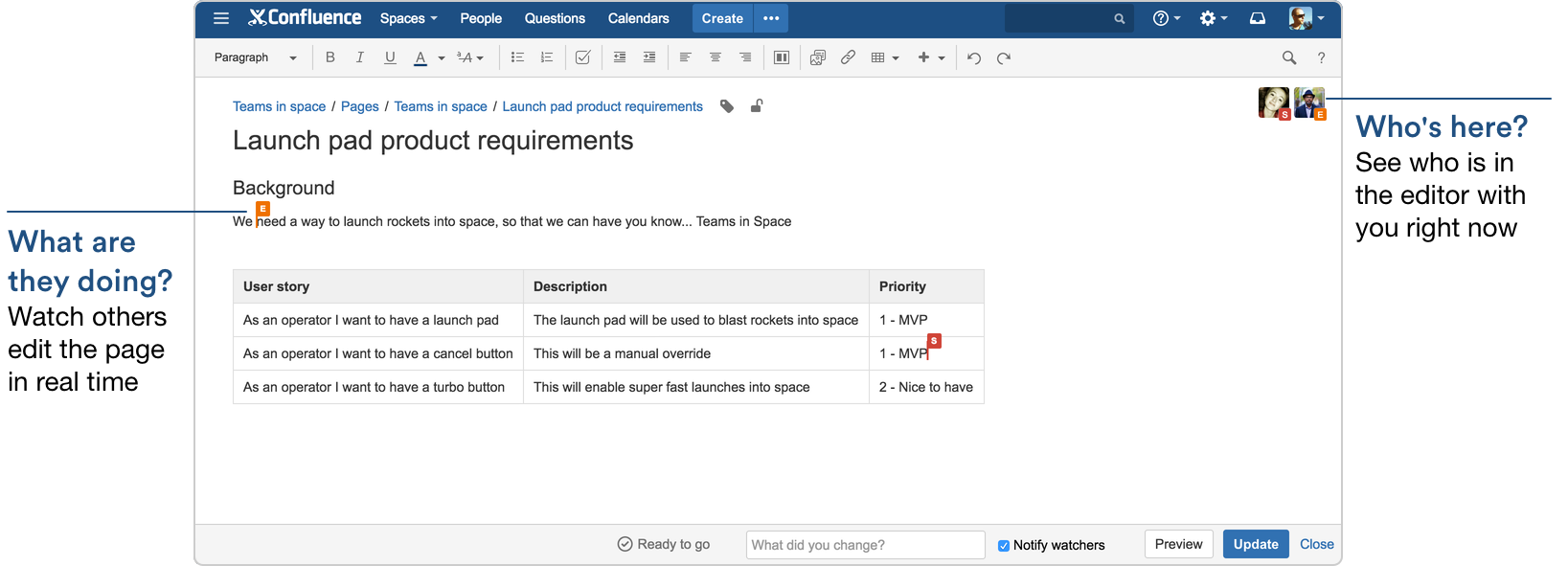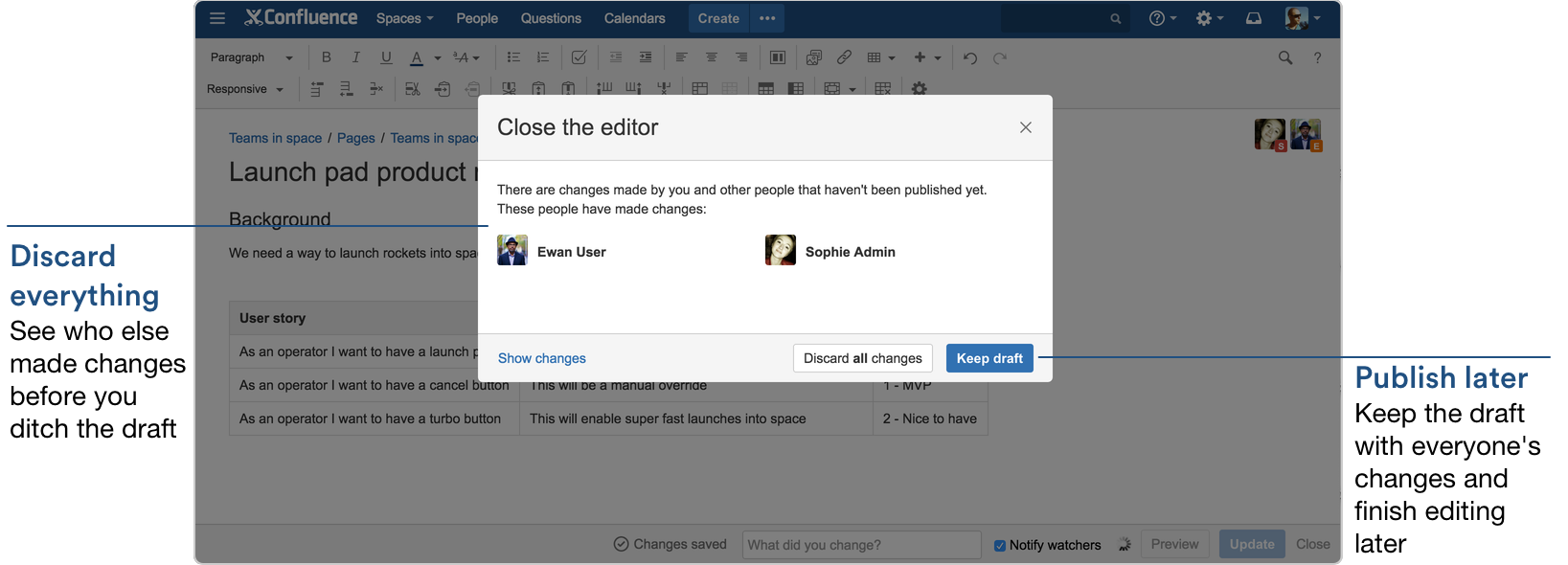Confluence 6.0.0-beta Release Notes
Development releases are not production ready. Development releases are snapshots of the ongoing Confluence development process. While we try to keep these releases stable, they have not undergone the same degree of testing as a full release, and could contain features that are incomplete or may change or be removed before the next full release.
No upgrade path. Because development releases represent work in progress, we cannot provide a supported upgrade path between development releases, or from any development release to a final release. You may not be able to migrate any data you store in a Confluence development release to a future Confluence release.
Atlassian does not provide support for development releases.
Highlights of 6.0.0-beta6
Released
This beta contains bug fixes and other improvements. No new features were added in this beta.
Issues with this milestone?
Please raise an issue to tell us about it.
Collaborative editing has arrived
The feature you've all been waiting for has arrived - collaborative editing. See who's editing the page with you, and see their changes in real time. Changes are automatically saved and synced so there's no need to ever manually save. Your only decision is when to publish the changes.
A word of warning - this feature is still in development. We know you're excited, but don't install this release in production (no matter how much you want collaborative editing right now) as you may not be able to roll back if things go wrong.
Working together in the editor
Collaborative editing doesn't mean you need to sacrifice the power of the Confluence editor. All your layouts, macros and other features are available.
Subtle cursors let you see who is in the editor with you, and what they're doing.
Publish when you're ready
One of the things that sets Confluence apart from other real-time editors is the separation between viewing a page and editing a page.
Your audience can continue to read your page, without seeing your edits in real time. This is super important when you're working on policies, procedures or documentation, those times where most of your audience are just reading, not editing.
Once you and your team are done editing you can:
- publish (or update if the page has previously been published) to make everyone's changes visible
- close the editor and keep everyone's work to finish later
- close the editor and discard everyone's changes.
We make it very clear if you are about to discard changes from more than just yourself!
What's under the hood?
The engine that powers collaborative editing is called Synchrony. When you install Confluence, Synchrony will be configured to run as a seperate process on your server.
Head to Administration menu , then General Configuration > Collaborative editing to administer collaborative editing for your site. System administrators can:
- Monitor and restart Synchrony.
- Change the editing mode to 'limited' to protect users shared drafts if you need to troubleshoot Synchrony issues.
- Turn off collaborative editing in your site.
Flexibility for Data Center installations
When you install Confluence Server, Synchrony is automatically configured to run as a seperate process on your server.
For Data Center, we give you full control by allowing you to set Synchrony up yourself. This gives you the flexibility to deploy Synchrony on the same nodes as Confluence, or in its own cluster with as many nodes as you need.
See Installing Confluence Data Center to find out how to set up your Synchrony cluster.
Introducing shared drafts
Collaborative editing introduces a new type of draft, a shared draft. Previously when you edited a page but didn't save it, Confluence would create a draft that was only visible to you (a personal draft). Now, Confluence creates a shared draft whenever anyone edits a page. All page editors work on this same shared draft, and it exists until someone publishes the page.
When you publish a shared draft, you're publishing all the changes you have made and changes made by others. Publishing creates a version in the page history.
If you discard a shared draft, you're discarding all changes, including changes made by others. Because shared drafts aren't versioned, there's no way to get a discarded draft back.
Accessing your personal drafts
Your personal drafts are still available, but are no longer editable. If you edit a page, you'll see the shared draft of the page, not your personal draft (if one exists).
If you need to get content out of your previous personal drafts head to Profile > Drafts, locate your page and copy the contents.
Copy page hierarchies
By popular demand, you can now copy a page and all its child pages in one easy process. Use it to duplicate existing content, kick off new projects with the perfect pro-forma page hierarchy, or take a snapshot of important pages - the possibilities are endless.
But that's not all, you can now also choose a location to copy to. No more copying a page and then manually moving it to another parent page or space.
No matter whether you copy into the same space or a different space - we give you the tools you need to modify page titles on the fly and control what's included in your new pages.
Delete page hierarchies
When deleting a page you now have the option to delete just the current page, or to delete the page and all its child pages. It's perfect for cleaning up old content or for quickly disposing of all those copies you can now make.
We'll warn you of any incoming links, and won't include links that are coming from pages that will also be deleted in the same batch, making it super easy to tidy up your links before you delete.
Upgrade notes
Collaborative editing system requirements
Before you upgrade your test server, you'll need to make sure you can meet the following requirements.
- Memory and CPU - you may need to give your test server more resources than for previous Confluence releases. The default maximum heap size for Synchrony is 2 GB.
- WebSockets - your firewall / proxies must be configured to allow WebSocket connections. An experimental XML HTTP Request (XHR) fallback feature is available by setting the system property
synchrony.enable.xhr.fallback=true. This may be used if it is discovered in production that some users can't access Confluence via WebSockets. Note that the XHR fallback isn't compatible with using the Synchrony proxy via Confluence. SeeCONFSERVER-44250 - XHR Fallback does not work with synchrony-proxy Closed
- Proxies - if you're running Confluence behind a proxy server, you'll need to add Synchrony, which runs on port 8091, to your config. See How to use NGINX to proxy requests for Confluence (you'll need NGINX 1.3 or later) or Using Apache with mod_proxy (you'll need Apache httpd 2.4) for more information.
- SSL termination - SSL termination must be configured on the load balancer / proxy server / gateway (if used) so that Synchrony can accept XHR requests from the web browser. For example if you've followed Using Apache with mod_proxy to add SSL, you'll need to do the same for Synchrony which runs on port 8091. If you're using NGINX see, Running Confluence behind NGINX with SSL.
- Database drivers - you must use a supported database driver. Collaborative editing will fail with an error if you're using an unsupported or custom JDBC driver (or
driverClassNamein the case of a JNDI datasource connection). See Database JDBC Drivers for the list of drivers we support.
Personal drafts are no longer editable
Collaborative editing introduces a new type of draft, a shared draft. Your users' personal drafts are still available, but are no longer editable. When they edit a page, they'll see the shared draft of the page, not your personal draft (if one exists).
Users will be able to access the content of their personal drafts at Profile > Drafts. They'll need to copy the contents manually to new pages.
Any personal drafts that have never been published (e.g. you have opened the editor, but never clicked save / publish) will be converted to a shared draft upon Resuming the draft. If you choose to turn collaborative editing off these will be lost.
No version history in drafts
We're saving all the time in collaborative editing, but we don't save versions in a draft. When discarding changes, you can only roll back to the last published version (thereby discarding all unpublished changes from all users).
Auditing considerations
We know that auditing is a major consideration for some customers. Collaborative editing does not currently offer full granularity auditing capabilities. Multiple users can now contribute to a shared draft which one user will publish to a new version. Each user is attributed to that version, rather than each users specific changes.
If this is going to be a problem in your site, you may consider turning collaborative editing off for now.
The documentation theme will be removed
When you upgrade to Confluence 6.0 the documentation theme will be removed from your site. We'll automatically turn on the default theme for any spaces that currently use the documentation theme.
If you've customized the documentation theme (by adding wiki markup to the sidebar, header or footer) we'll take this wiki markup and drop it into the sidebar, header and footer in the default theme. Your space sidebar will look a little different after the upgrade but in most cases the changes shouldn't be dramatic.
See our documentation theme migration FAQ for answers to all your questions about the doc theme.
Changes to CSS classes
If you have overrided the space CSS to change the appearance of the documentation theme, you'll probably need to make some changes to your CSS, as some class and ID names are different between the two themes. For example, instead of specifying #splitter-sidebar , you'll need to use .acs-side-bar.
Problems with customized layouts
If you have customized default theme layouts through the Confluence UI, you may find that your space looks strange or broken when the default theme is re-applied to spaces previously using the documentation theme.
We think this issue is likely to only impact our long time customers, who have customized site or space default theme layouts prior to upgrading to Confluence 5.0 and who later turned on the documentation theme.
If you experience problems, you'll need to reset the broken layouts.
Space jump macro will be removed
The space jump macro was provided by the documentation theme and will not be available in Confluence 6.0. If you've used this macro on a page or in the header or footer of a space, it will show the following error after the upgrade unknown macro: {spacejump}.
To find out whether the Space Jump macro is used on any pages in your site before you upgrade, enter macroName:spacejump into the search bar. All pages containing the macro will be returned (it won't search the sidebar, header or footer unfortunately).
Infrastructure changes
Head to Preparing for Confluence 6.0 to find out about changes that will impact plugin developers. You can also read more about how Collaborative editing for Confluence Server works under the hood, and find out how you can make sure your add-on is compatible.
We will not be providing 32-bit installers for Confluence 6.0. If you're running Confluence on a 32-bit system, you can still upgrade using the archive file method.
Supported platform changes
In this release, we've ended support for:
- Internet Explorer 10
- MySQL 5.5


